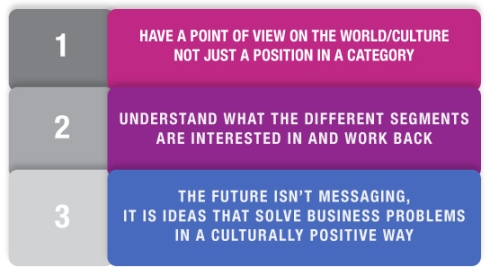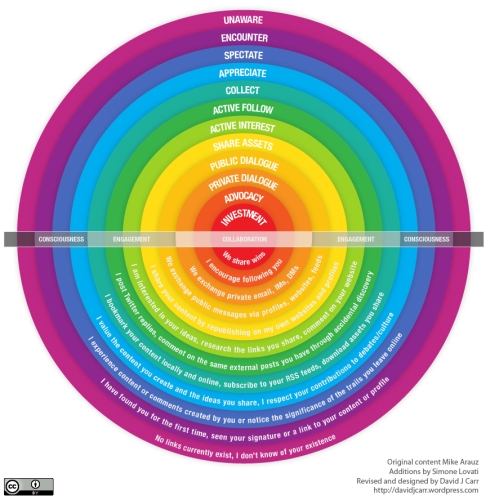I got talking to the COI the other day about online PR, Word of Mouth and Social Media and the conversation turned to the problems of ROI and monitoring.
I’ve sat in too many Social Media presentations that promise a bit about ROI at the end but instead of a practical approach just mention “the power of conversations”, list a few free tools and then mention one of the larger monitoring services.
Unfortunately despite people intuitively knowing that the social and consumer-centric business approach is the future for marketing and communications, this won’t convince a CFO or the global board. They like models and numbers.
So off the back of this I took an earlier post based on some of Mike Arauz’s thinking and started to try and categorise the numerous, different monitoring techniques out there to make comparing like with like more possible.
Anyway here goes…
An approach to Social Media Monitoring and measurement based on the spectrum of online relationships
Increasingly the value of an idea is not in its initial direct exposure, blog mention or spot/insertion in a publication, but in the value or social currency it provides to the audience. This social oxygen value enables the idea to spread socially.
Social Media campaigns are uniquely measurable but not all measures are equal and indicate true effectiveness. Different social media actions or online conversations have different values and influences upon consumer behaviour.
Multiple metrics, from number of followers and fans, to positive or negative sentiment, to reposts and influencer mentions, can be difficult to distinguish from one another. In effect we can become trapped in a state of analysis paralysis where there is too much social media data and too little understanding.
An agreed industry standard is needed but, until a consensus arises, we have developed a structure to categorise the value of different monitoring tools/metrics and start building an measurement and tracking model.

fig. 1 – Spectrum of Online Relationships
By classifying social media conversations into three categories – Exposure, Engagement, Collaboration – based on the Spectrum of Online Relationships that underpin them (fig 1), we can group their associated metrics and monitoring approaches (fig 2). Then by examining the overall performance of the activity in each category we can begin to establish the effectiveness and conversion rate of social media campaigns and ongoing activity.
The idea is to simplify all the different effectiveness measures out there so comparisons/trends can be made and then these can then used alongside true Social ROI calculations.

fig. 2 - Social Media Monitoring, Metrics and measurement tools by category
Categorising social media activity this way means it is possible to take a holistic approach and use aggregates of the different monitoring techniques – and metrics that will vary according to the nature of every campaign and its platform type – to compare the performance between each category and hence work out the relative success of the social media activity. The ultimate goal of this approach is to be able to compare the effectiveness of different social media campaigns when comparing like with like is often difficult.
Using this structure means that the results of the Exposure, Engagement and Collaboration categories can be compared to identify performance and trends.
I’ve arrange an example of this way of thinking as an equation (which is sure to attract the wrath of Anna O’Brien who rightly points out the falseness of the different social media “ROI metrics” and silly equations out there) but it is not meant to be a magic bullet or mathematically sound – it is a visual way of structuring thinking about the principles at play.
For example, one measure of a social media campaign’s momentum – Social Media Traction – would be to compare the ratio of Engagement performance to Exposure performance (Fig 3) where a +1 would indicate success and social media momentum as people moved from being merely exposed to a campaign to becoming more engaged.
Any measure/inputs of Exposure or Engagement (or even Collaboration) would differ for each campaign and organisation – as I said earlier the idea is to simplify the different effectiveness measures and monitoring techniques so comparisons can be made and trends identified.

fig. 3 – A way of thinking about a campaign’s traction by comparing performance in the Exposure and Engagement categories
Equally using this approach to define Social Media Conversion and Advocacy would require a focus on activity and metrics within the Collaboration category. Indeed, the ratio between Engagement performance and Collaboration performance could be seen as being an indicator of people moving from discovering, sharing and “playing” with content to acting upon it – whether making it their own passion or hopefully even changing purchasing behaviour.
Ultimately this proposed approach to Social Media monitoring/measurement will need to be linked back to ROI. Can we prove whether good results in either category – or a good Social Media Traction or Social Media Conversion and Advocacy score – can relate to a lower Cost per Acquisition or an increase sales?
This will require someone much better at maths than me but I believe that some agreed structure and model is vital to proving the long term value of social media and the real web to the board and CFO.
Tags: digital campaign measurement, Feature, infographic, measurement, Return on investment, ROI, social media, social media monitoring, social networks, Trends




















